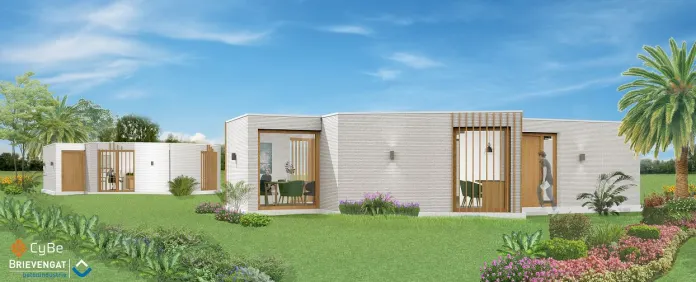Dutch technology provider CyBe Construction and Curaçao concrete expert Betonindustrie Brievengat (BIB) are joining forces for a strategic partnership. At the end of September, three operators of BIB will be trained by the team of CyBe to operate the purchased 3D printer. This is through a 10-day on-site training during which the first two buildings will be printed in the island of Curaçao, the first-ever 3D construction printing initiative in the Caribbean archipelago. These two buildings will serve as office space and café in Willemstad, the capital city of Curaçao.

A first for the Caribbeans
Betonindustrie Brievengat (BIB) has over 80 years of experience in the market of concrete products. It is the market leader in Curacao and for both consumers and contractors BIB has proven to be a reliable partner in recent years. By constantly looking for innovative solutions, cooperation has been made possible in 3D concrete printing.
Worldwide 3D printing is no longer an unknown concept, in recent years this way of building has made its appearance. In the emerging 3D printing sector for construction, technology and knowledge are managed by a relatively small number of companies, each of which pursues its vision and offers products/services. Among these companies, Dutch technology provider CyBe Construction is also active.
A sound business case from BiB
Not only in Curaçao but also worldwide the housing shortage is an increasingly serious problem. Countries around the world are facing a housing crisis, with a huge shortage of housing for the growing population.
Due to the innovative character of its parent company Janssen de Jong Group, BiB can solve this problem in the Caribbean. “With the arrival of this 3D concrete printer, we want to be a leader in the field of construction innovation in the Caribbean and make affordable and modern living possible for the population,” said Kurt Verbist, Cluster Director Janssen de Jong Curaçao & Bonaire. To this end, both companies have come up with a balanced business case with which 3D concrete printing is competitive in terms of both time and price compared to traditional local construction. This has been achieved by the various designs that CyBe offers and the diversity in 3D concrete printing systems. An additional benefit is the speed and freedom of design made possible by 3D concrete printing. CyBe has responded to this by developing the Lyve by CyBe design label. Various printable building designs have been created which are easy to integrate per area. As the slogan of BiB says; Always One Step Ahead.
Manufacturing on Demand
Lyve by CyBe design
In addition to the housing shortage, there is currently a shortage of raw materials and labor. In light of these problems, a different approach to the way construction is organized and works are crucial. This means a holistic approach, which fits within CyBe’s vision and construction approach. “It is increasingly difficult to build affordably, thanks to 3D concrete printing in combination with the Lyve by CyBe housing design we can solve this problem. As an experienced knowledge leader and technology provider with 3D concrete printers in every continent, we were able to add BiB as a solid and progressive partner for the Caribbean,” said Berry Hendriks, CEO & Founder CyBe Construction.
The first two buildings from the Lyve by CyBe design label will be 3D printed. The patio will serve as office space and the robust villa as a café. Angelo Bonevacia, General Manager BIB, is enthusiastic about the first houses: “With this innovative solution we want to serve a new segment in the market. As our slogan says: ‘Always One Step Ahead’”. Currently, the third building is being designed by CyBe, which will also serve as a unique office space. Further developments between BiB and CyBe will soon lead to more designs and buildings from the Lyve by CyBe design label.
Experience in the 3D construction industry
Founder and CEO of CyBe Construction, Berry Hendriks, knows better than anyone how traditional construction works. Hendriks has been part of the Dutch construction industry for a long time. His family started in 1922 and still runs a construction company in the Netherlands. Hendriks’ knowledge and experience in the construction sector have created a unique perspective coming to the realization that the construction process can be made more efficient. Where traditional construction solutions are complex and time-consuming, construction 3D printing offers solutions to develop complex shapes. Automating construction processes to save cost and time in the construction of various projects and products.
Faster, more sustainable and affordable
The 3D printing of concrete that allows the realization of houses, street furniture, artificial reef and many more designs is on the rise. This technique is one of the most innovative methods in the industry, offering new solutions that traditional construction methods cannot achieve. Since 2013, CyBe has been developing 3D concrete printers and applying this technology to redefine the construction industry. Globally, CyBe is active with the sale of 3D concrete printers, in the Netherlands the company itself works as a main contractor.
Besides offering 3D concrete printers, CyBe also offers its own software (Chysel and Artysan), materials (CyBe Mortar), Design & Engineering and its own learning platform (CyBe Lybrary). This makes it possible to offer solutions to simplify complex construction processes and to collaborate more efficiently around 3Dcp, with the major benefits of faster and more sustainable construction production. Through CyBe Mortar, it has been possible to create a 32% CO2 reduction. Compared to other mortars, CyBe Mortar is hard within 3 minutes and at structural strength in just one hour. In addition, the material is produced locally, which significantly reduces transportation costs. This allows for a fast and efficient printing process, reduced costs and sustainable results.
* This article is reprinted from 3D Printing Media Network. If you are involved in infringement, please contact us to delete it.
Author: Davide Sher


Leave A Comment